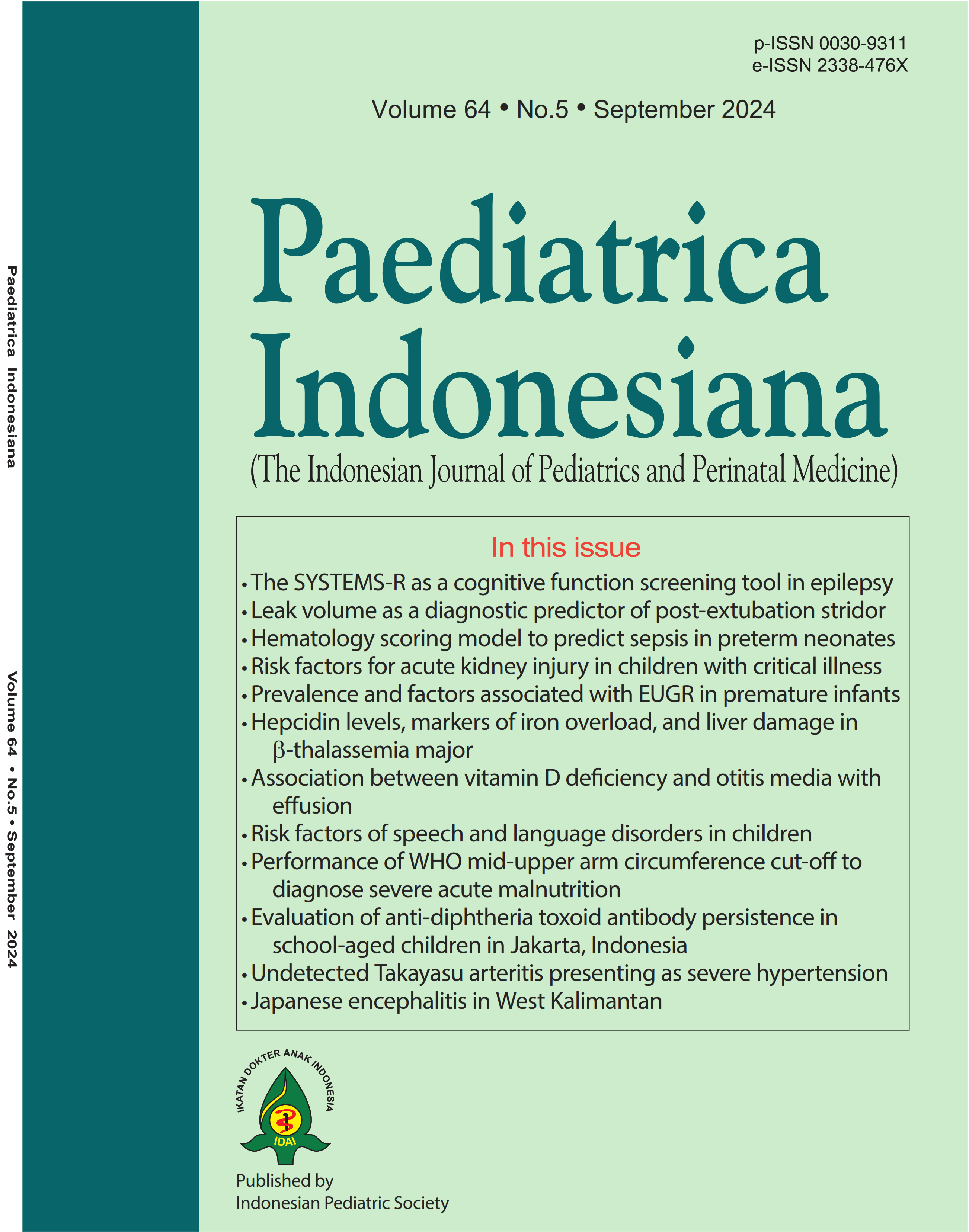Measurement of leak volume as a diagnostic predictor of post-extubation stridor in pediatric patients
DOI:
https://doi.org/10.14238/pi64.5.2024.384-8Keywords:
post-extubation stridor; leak volume; percent leak volumeAbstract
Background Endotracheal intubation can cause post-extubation stridor (PES). The PES may prolong the length of stay in the hospital and be associated with increased morbidity and mortality, particularly if re-intubation is necessary. The leak volume (LV) test is a simple method to detect airway edema.
Objective To evaluate the efficacy of LV and percent leak volume (PLV) in predicting PES.
Methods Inspired tidal volume (VTi) and expired tidal volume (VTe) were observed for six respiratory cycles during positive pressure ventilation before extubation. The average of the six VTi and six VTe values were recorded. The LV was the difference between average VTi and average VTe. The conversion of the ratio of LV to average VTi into percentage was defined as PLV. Both LV and PLV were analyzed to determine cut-off values in predicting PES.
Results Among 77 patients, 39 patients (50.6%) developed PES. Both LV and PLV showed a significant decrease in patients with PES.The ROC analysis showed that LV at a cut-off point of < 18.34 ml gave a sensitivity of 82.1% and specificity of 57.9%, whereas PLV < 13.83% yielded 79.5% sensitivity and 57.9% specificity for predicting PES. The LV and PLV had an area under the ROC curve of 0.770 (95%CI 0.665 to 0.874; P<0.001) and 0.706 (95%CI 0.59 to 0.821; P=0.01) respectively.
Conclusion Leak volume and percent leak volume can be used as markers to predict PES in pediatric patients.
References
Principi T, Fraser DD, Morrison GC, Farsi SA, Carrelas JF, Maurice EA, et al. Complications of mechanical ventilation in the pediatric population. Pediatr Pulmonol. 2011; 46: 452-7. DOI: https://doi.org/10.1002/ppul.21389
Wittekamp BH, van MooK WN, Tjan DH, Zwaveling JH, Bergmans DC. Clinical review: post-extubation laryngeal edema and extubation failure in critically ill adult patients. Crit Care. 2009; 13:233. DOI: https://doi.org/10.1186/cc8142
Zhou T, Zhang HP, Chen WW, Xiong ZY, Fan T, Fu JJ, et al. Cuff-leak test for predicting post-extubation airway complications: A systematic review. J Evid Based Med. 2011; 4: 242-54. DOI: https://doi.org/10.1111/j.1756-5391.2011.01160.x
Wratney AT, Benjamin Jr DK, Slonim AD, He J, Hamel DA, Cheifetz IM. The endotracheal tube air leak test does not predict extubation outcome in critically ill pediatric patients. Pediatr Crit Care Med. 2008; 9: 490-6. DOI: https://doi.org/10.1097/PCC.0b013e3181849901
Thachil TJ, Kuriakose BK, Nayak VR, Khadke V. Cuff leak test for predicting post extubation stridor in intubated adult patients – A prospective observational study. Indian J Public Health Res Dev. 2021; 12: 518-22. DOI: https://doi.org/10.37506/ijphrd.v12i3.16120
Kuriyama A, Jackson JL, Kamei J. Performance of the cuff leak test in adults in predicting post-extubation airway complications: a systematic review and meta-analysis. Crit Care 2020; 24: 640. DOI: https://doi.org/10.1186/s13054-020-03358-8
Mhanna MJ, Yaacov BZ, Tichy CM, Super DM. The “air leak” test around the endotracheal tube, as a predictor of post-extubation stridor, is age dependent in children. Critical Care Medicine. 2002; 30: 2639-43. DOI: https://doi.org/10.1097/00003246-200212000-00005
Seid AB, Godin MS, Pransky SM, Kearns DB, Peterson BM. The prognostic value of endotracheal tube-air leak following tracheal surgery in children. Arch Otolaryngol Head Neck Surg 1991; 117:880-2. DOI: https://doi.org/10.1001/archotol.1991.01870200074011
Finholt DA, Henry DB, Raphaely RC. Factors affecting leak around tracheal tubes in children. Can Anaesth Soc J 1985; 32: 326-9. DOI: https://doi.org/10.1007/bf03011335
Amrousy DE, Elkashlan M, Elshmaa N, Ragab A. Ultrasound-guided laryngeal air column width difference as a new predictor for postextubation stridor in children. Crit Care Med. 2018; 46: e496-e501. DOI: https://doi.org/10.1097/ccm.0000000000003068
Ding L, Wang H, Wu HD, Chang C, Yang P. Laryngeal ultrasound: a useful method in predicting post-extubation stridor. A pilot study. Eur Respir J 2006; 27: 384-9. DOI: https://doi.org/10.1183/09031936.06.00029605
Downloads
Published
How to Cite
Issue
Section
License
Authors who publish with this journal agree to the following terms:
Authors retain copyright and grant the journal right of first publication with the work simultaneously licensed under a Creative Commons Attribution License that allows others to share the work with an acknowledgement of the work's authorship and initial publication in this journal.
Authors are able to enter into separate, additional contractual arrangements for the non-exclusive distribution of the journal's published version of the work (e.g., post it to an institutional repository or publish it in a book), with an acknowledgement of its initial publication in this journal.
Accepted 2024-10-14
Published 2024-10-14














